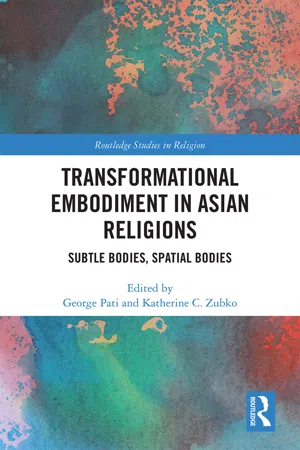
Transformational Embodiment in Asian Religions
Subtle Bodies, Spatial Bodies
- 250 pages
- English
- ePUB (mobile friendly)
- Available on iOS & Android
Transformational Embodiment in Asian Religions
Subtle Bodies, Spatial Bodies
About This Book
This volume examines several theoretical concerns of embodiment in the context of Asian religious practice. Looking at both subtle and spatial bodies, it explores how both types of embodiment are engaged as sites for transformation, transaction and transgression.
Collectively bridging ancient and modern conceptualizations of embodiment in religious practice, the book offers a complex mapping of how body is defined. It revisits more traditional, mystical religious systems, including Hindu Tantra and Yoga, Tibetan Buddhism, Bon, Chinese Daoism and Persian Sufism and distinctively juxtaposes these inquiries alongside analyses of racial, gendered, and colonized bodies. Such a multifaceted subject requires a diverse approach, and so perspectives from phenomenology and neuroscience as well as critical race theory and feminist theology are utilised to create more precise analytical tools for the scholarly engagement of embodied religious epistemologies.
This a nuanced and interdisciplinary exploration of the myriad issues around bodies within religion. As such it will be a key resource for any scholar of Religious Studies, Asian Studies, Anthropology, Sociology, Philosophy, and Gender Studies.
Frequently asked questions
Information
1 The subtle body of vital presence in contemplative practices of Abhinavagupta’s Trika Śaivism and Longchenpa’s Great Perfection
Introduction
Abhinavagupta’s dazzling bright and spinning wheel of fire
Ultimate Reality lights up, in our intellect-vital breath-body complex. These are not separate from the Light, which is only Consciousness. Because of Consciousness’s freedom, It has two qualities: the body of Consciousness, and insentience.12
First, center one’s awareness in the Heart. Second, visualize the subtle body, i.e., visualize one’s body as containing three channels. One breathes in through the top of the head to the Heart through the left channel, which is imagined as glowing as the breath-energy flows through. One retains the breath, being centered in the Heart. Then one breathes out starting at the Heart through the right channel and out through the top of the head. One continues, slowly extending length of pause, until a bodily-felt energy, the Fire of Mahābhairava, suddenly flashes forth in the Heart. Third, one visualizes the energy as a fire wheel with twelve spokes, pulsing and spinning in the Heart, exiting through one of the sense openings (eye, ear, or another opening). The wheel leaves the body and rests on a sense object, corresponding to the sense opening (a visual object; for example, if the wheel exited through the eyes, and so on). Fourth, as the pulsating, spinning wheel rests on the object, the practitioner imagines that the object is an emission of their own consciousness and is being filled with divine energy. Then, dissolve the object in the fire wheel as it reenters the body through same sense opening as before and then rises through central channel to dissolve in Void at the top of the head as one exhales. Fifth, after the wheel has rested into the silence of the space at the top of the head, one rests there in complete stillness of the Void. Sixth, repeat process, now using the memory of the object instead of a real object.
Moon-Sun-Fire, one should contemplate on their fusion, thinking nothing else. From the rubbing together of the firesticks of this contemplation, the oblation-eating fire of Mahābhairava, in the great sacrificial pit of the Heart, intensely setting aflame, one should make it flourish. One should meditate on the abodes of knower, known, and the knowing, indivisible with the radiant presence of Bhairava and his expansive power.15
This No-Thing-Higher Cakra, from the Heart, flows out through the spaces of the eyes [and the other senses],20 into the various fields of sense-objectivity. Thus, onto the sensory field of sound and so forth, through the pathway of the space of the sensory organ of hearing and so forth, through this Cakra falling, [the practitioner] recognizes [the field and the Cakra] as identical [to Bhairava]. Like a powerful lord, the universal emperor, this [Dazzling Bright Spinning Wheel, the Cakra which has become the Fiery Bhairava, the Great Tremendum], the nature of all, wherever it falls through this process [is followed by its senses, just as the emperor is followed by his subjects].21
Table of contents
- Cover
- Half Title
- Series Page
- Title Page
- Copyright Page
- Dedication
- Table of Contents
- List of figures
- Notes on transliteration
- Notes on contributors
- Acknowledgments
- Introduction
- 1 The subtle body of vital presence in contemplative practices of Abhinavagupta’s Trika Śaivism and Longchenpa’s Great Perfection
- 2 Daoist body-maps and meditative praxis
- 3 Yuasa Yasuo’s contextualization of the subtle body: phenomenology and practice
- 4 Dismembering demons: spatial and bodily representations in the fifteenth-century Ekaliṅgamāhātmya
- 5 Subtle body: rethinking the body’s subjectivity through Abhinavagupta body
- 6 Embodied experience in the Mahārthamañjarī of Maheśvarānanda
- 7 Sensing the ascent: embodied elements of Muhammad’s heavenly journey in Nizami Ganjavi’s Treasury of Mysteries
- 8 Bodies in translation: esoteric conceptions of the Muslim body in early-modern South Asia
- 9 The prostituted body of war: U.S. military prostitution in South Korea as a site of spiritual activism
- 10 Frisky methods: subtle bodies, epistemological pluralism and creative scholarship
- 11 Bliss and bodily disorientation: the autophagous mysticism of Georges Bataille and the Taittirīya Upaniṣad
- Index